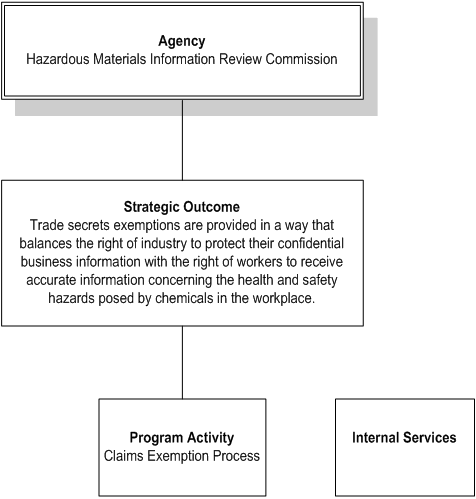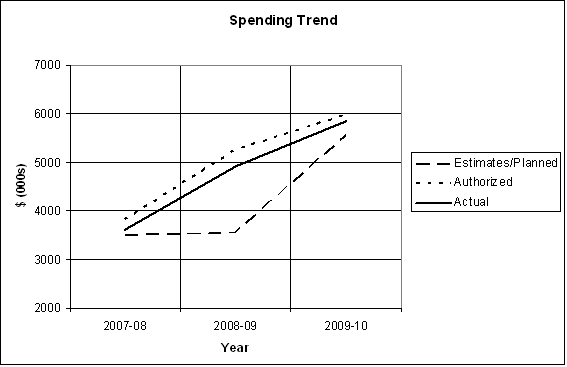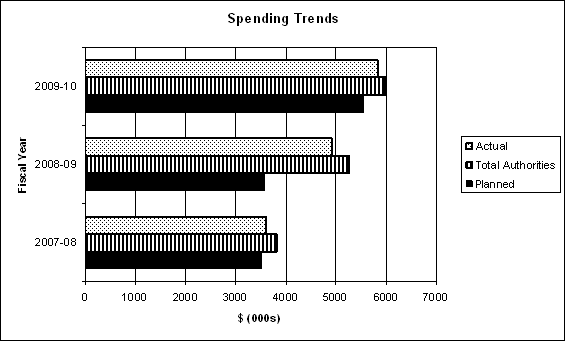Common menu bar links
Breadcrumb Trail
ARCHIVED - Hazardous Materials Information Review Commission - Report
 This page has been archived.
This page has been archived.
Archived Content
Information identified as archived on the Web is for reference, research or recordkeeping purposes. It has not been altered or updated after the date of archiving. Web pages that are archived on the Web are not subject to the Government of Canada Web Standards. As per the Communications Policy of the Government of Canada, you can request alternate formats on the "Contact Us" page.
President's Message
As President and Chief Executive Officer of the Hazardous Materials Information Review Commission (HMIRC), it is my pleasure to submit to Parliament and to Canadians our 2010-11 Departmental Performance Report. This report provides a summary of the Commission's performance and the resources required in the last fiscal year in order to fulfil its mandate. The mandate of the Commission is to act as a national mechanism to protect the trade secrets of companies operating in Canada while ensuring compliant health and safety information for workers. This aligns us with the Government of Canada's strategic outcome of Healthy Canadians and, as well, supports the outcome of A Fair and Secure Marketplace.
The crowning achievement of 2010-11 has been the elimination of the backlog of claims for exemption. This backlog had accumulated over several years due to an increase in the volume and complexity of claims, causing a delay in the provision of accurate health and safety information. Beginning in 2008, however, a three-year initiative was funded and implemented to specifically address this situation. Now the backlog is gone, the Commission can focus its efforts in other important areas, such as improving earlier compliance in associated Material Safety Data Sheets (MSDSs) submitted by claimants while ensuring that claim applications are processed expediently.
Over the past year the Commission has continued to explore and develop ways to support the three strategic directions endorsed by HMIRC's Council of Governors. These directions are: enhancing proactive compliance with Workplace Hazardous Materials Information System (WHMIS) requirements, improving the translation and dissemination of HMIRC knowledge on hazard classification and communication, and increasing partnerships. An example where the Commission can count success in earlier compliance is in claimant acceptance of undertakings, resulting in fewer orders, and the ongoing use of the MSDS checklist, both of which allow verified health and safety information to be made available earlier to workers. This is substantiated by an overall continuing decrease in MSDS violations.
Organizational alignment and cohesion has been strengthened through the implementation of HMIRC's Integrated Plan 2010-12. The Plan effectively links the activities carried out by the Commission to short, medium and long term outcomes, the strategic directions and the mandate. A logic model has been developed which offers a clear illustration of these links and this has been distributed across the Commission. An operational component provides the necessary detail of resources and an evaluation methodology has established indicators and targets for measuring achievement.
Regarding another aspect of the Commission, the Strong Workplace Action Team (SWAT), a working group of employees from across the organization, has done an admirable job in identifying and consulting widely on issues in the workplace and in proposing solutions. SWAT has been committed to making HMIRC a workplace of choice that is healthy, productive and accountable with a workforce that is responsible and engaged.
I am indebted to HMIRC staff for their valuable and solid contribution to realizing the Commission's goals, and to the Council of Governors for their ongoing dedication and support. I am proud of the significant accomplishments we have made at the Commission in the last year, especially through collaboration and innovation, and that we are continually improving health and safety information for Canadian workers.
Sharon A. Watts
President and CEO
Section I: Organizational Overview
Raison d’�tre
The Hazardous Materials Information Review Commission (HMIRC) provides a single mechanism under federal, provincial and territorial legislation to protect the trade secrets of companies that supply or use hazardous materials, and ensures that Canadian workers who handle such materials have all the information they need to do so safely.
Responsibilities
The Commission enables companies to protect their trade secrets and, at the same time, ensures that Material Safety Data Sheets (MSDSs) for products with trade secrets used by workers in Canada disclose complete and accurate information to reduce workplace-related illness and injury. The Commission's activities are key components of the Workplace Hazardous Materials Information System (WHMIS), which was created in 1987 through a consensus between workers, industry and government. The success of WHMIS depends on cooperation among all these partners. All three groups play an integral part in ensuring that chemical products are used as safely as possible in Canadian workplaces.
WHMIS requires that suppliers provide employers with MSDSs and product labels which detail information on the hazards of materials sold for use in Canadian workplaces. The employers, in turn, provide these MSDSs and labels to workers and, as well, training on how to handle the products safely. A product's MSDS must fully disclose all hazardous ingredients in the product, their toxicological properties, the safety precautions workers need to take when using the product, treatment required in the case of injury, and other pertinent information.
When a supplier introduces a product and wants to protect the identity or concentration of one or more of the hazardous ingredients, according to the Hazardous Materials Information Review Act (HMIRA), the company needs to apply to HMIRC for an exemption from the requirement to list all hazardous ingredients on the product's MSDS. Once HMIRC registers a claim, the product can be made available in the marketplace without disclosing the confidential business information. The Commission then evaluates the claim and issues a decision on its validity and, to protect workers, verifies the compliance of the MSDS with the Hazardous Products Act and the Controlled Products Regulations.
When an employer purchases a product and wants to protect the identity and/or concentration of any hazardous ingredients, or the name and the supplier of the product, according to the HMIRA, the company also needs to apply to HMIRC for an exemption. In this case, in addition to issuing a decision on the claim's validity, the Commission evaluates the MSDS and, if necessary, the label, against the requirements of either the Canada Labour Code, for federally regulated employers, or the relevant provincial or territorial occupational health and safety legislation.
Where areas of non-compliance are identified, the Commission offers claimants the opportunity to make corrections through voluntary compliance undertakings. If the claimant chooses not to accept the undertaking, the Commission issues formal orders obligating the claimant to make the changes.
In cases where there are disputes that cannot be resolved, HMIRC convenes independent boards to hear appeals from claimants or affected parties challenging decisions and orders or from affected parties challenging undertakings signed by claimants and accepted by HMIRC.
In addition, HMIRC responds to requests from federal, provincial or territorial government health and safety officials for information about claims for exemption to help these officials administer and enforce their WHMIS obligations.
Strategic Outcome(s) and Program Activity Architecture (PAA)

Organizational Priorities
Priority Status Legend
Exceeded: More than 100 per cent of the expected level of performance for the priority identified in the corresponding RPP was achieved during the fiscal year.
Met All: 100 per cent of the expected level of performance for the priority identified in the corresponding RPP was achieved during the fiscal year
Mostly Met: 80 to 99 per cent of the expected level of performance for the priority identified in the corresponding RPP was achieved during the fiscal year
Somewhat Met: 60 to 79 per cent of the expected level of performance for the priority identified in the corresponding RPP was achieved during the fiscal year
Not Met: Less than 60 per cent of the expected level of performance for the priority identified in the corresponding RPP was achieved during the fiscal year
| Priority | Type | Strategic Outcome(s) and/or Program Activity(ies) |
|---|---|---|
| Priority 1: Enhanced approach to support proactive compliance | Type 1: Ongoing | Strategic Outcome 1 and Program Activity 1.1 |
| Status: Met All | ||
|
||
1 Type is defined as follows: Previously committed to - committed to in the first or second fiscal year before the subject year of the report; Ongoing - committed to at least three fiscal years before the subject year of the report; and New - newly committed to in the reporting year of the DPR.
| Priority | Type | Strategic Outcome(s) and/or Program Activity(ies) |
|---|---|---|
| Priority 2: Improved knowledge translation to support hazard classification and communication | Type 1: Ongoing | Strategic Outcome 1 and Program Activity 1.1 |
| Status: Met All | ||
|
||
1 Type is defined as follows: Previously committed to - committed to in the first or second fiscal year before the subject year of the report; Ongoing - committed to at least three fiscal years before the subject year of the report; and New - newly committed to in the reporting year of the DPR.
| Priority | Type | Strategic Outcome(s) and/or Program Activity(ies) |
|---|---|---|
| Priority 3: Increased partnerships to better address hazard communication challenges | Type 1: Previously committed to | Strategic Outcome 1 and Program Activity 1.1 |
| Status: Met All | ||
|
||
1 Type is defined as follows: Previously committed to - committed to in the first or second fiscal year before the subject year of the report; Ongoing - committed to at least three fiscal years before the subject year of the report; and New - newly committed to in the reporting year of the DPR.
| Priority | Type | Strategic Outcome(s) and/or Program Activity(ies) |
|---|---|---|
| Priority 4: Organizational cohesion and coherence | Type1: New | Internal Services |
| Status: Met All | ||
|
||
1 Type is defined as follows: Previously committed to - committed to in the first or second fiscal year before the subject year of the report; Ongoing - committed to at least three fiscal years before the subject year of the report; and New - newly committed to in the reporting year of the DPR.
Risk Analysis
Operational Context
Labour, industry and government agree on the importance of preventing illnesses and injuries from hazardous materials in Canadian workplaces. In order to help achieve this goal WHMIS was created through the adoption of laws and regulations and the development of procedures in the late 1980s. WHMIS requires suppliers, including manufacturers, importers and distributors, and employers, to provide health and safety information about the chemicals produced or used in Canadian workplaces.
As part of the WHMIS initiative, the HMIRA and its regulations also came into force. This legislation established HMIRC, an independent agency with a quasi-judicial role. The Commission provides the mechanism in Canada to protect the confidential business information of chemical suppliers and employers and to ensure accurate and complete health and safety information is available to workers.
Risks and Opportunities
The Commission successfully eliminated a backlog of 512 claims by March 31, 2011 through three-year sunset funding (2008-11). The Commission will need to actively monitor the volume of claims for exemption registered in order to ensure it has the capacity to make accurate health and safety information available to workers in a timely manner.
The implementation of GHS in Canada will impact hazard communication under WHMIS. In order to contribute to the transmission of accurate and consistent information, HMIRC will need to continue to augment its knowledge base, participate in implementation discussions and keep informed of national and international developments.
The exclusive work that the Commission performs allows it to gather unique information. Through increased analysis, synthesis and dissemination of this information and knowledge, HMIRC can enhance the completeness, accuracy, comprehensibility and accessibility of hazard communications.
Due to its size and the complexity and specialization of its work, it is essential to staff positions at HMIRC in an expedient manner to ensure appropriate capacity, continuity and corporate memory. A critical component in the accomplishment of the Commission's business objectives is the recruitment and retention of a skilled, motivated, representative and stable workforce, and one that meets the challenge of new and evolving science.
Summary of Performance
2010-11 Financial Resources ($ thousands) 2
| Planned Spending | Total Authorities | Actual Spending |
|---|---|---|
| 5,704 | 5,973 | 6,066 3 |
2010-11 Human Resources (FTEs)
| Planned | Actual | Difference |
|---|---|---|
| 54 | 43 | 11 4 |
| Performance Indicators | Targets | 2010-11 Performance |
|---|---|---|
| Number of appeals as a percentage of total claims processed | Zero | Zero |
| Program Activity | 2009-10 Actual Spending ($ thousands) |
2010-11 ($ thousands) | Alignment to Government of Canada Outcomes | |||
|---|---|---|---|---|---|---|
| Main Estimates |
Planned Spending |
Total Authorities |
Actual Spending |
|||
| Program Activity 1.1: Claims Exemption Process | 5,845 5 | 4,232 | 4,232 | 4,216 | 3,306 | Healthy Canadians |
| Total | 5,845 | 4,232 | 4,232 | 4,216 | 3,306 | |
| Program Activity | 2009-10 Actual Spending ($ thousands) |
2010-11 ($ thousands) 2 | |||
|---|---|---|---|---|---|
| Main Estimates |
Planned Spending |
Total Authorities |
Actual Spending |
||
| Internal Services | 1,472 | 1,472 | 1,757 | 2,760 | |
2 Financial Resources equals the Total line for Program Activities and Internal Services.
3 The difference is due to a technical financial transaction error - the transfer of funds from Salaries and Wages to O&M which incurred additional EBP costs - resulting in an over-expenditure of spending authorities.
4 The difference in actual versus planned FTEs is due to the difficulty in recruiting qualified biologists with a specialization in toxicology, an identified shortage group in the public service and, in Internal Services, a review of administrative positions and the use of an interdepartmental MOU.
5 Commencing in the 2009-2010 Estimates cycle, the resources for the Internal Services program activity are displayed separately from other program activities; they are no longer distributed among the remaining program activities, as was the case in previous Main Estimates. This has affected the comparability of spending
and FTE information by program activity between fiscal years.
HMIRC, however, did not include Internal Services in its initial ARLU for 2009-2010 and therefore it was not part of either the Main estimates or the RPP for 2009-2010. Consequently, there is no data to report on for Internal Services for 2009-2010. Internal
Services has been included in the RPP and Main estimates for HMIRC for 2010-2011 and on.
Expenditure Profile
Graph 1

Graph 2

In 2007-2008, HMIRC developed a plan to eliminate its backlog of claims for exemption over a three year period (2008-2011) and to prevent it from recurring. However, due to the size of the organization's A-Base, which in fiscal year 2007-2008 totaled $3.5 M, the Commission sought supplementary funding for each of the three years, as well as ongoing funding, for 2011-2012 and beyond, to ensure operational capacity and support functions.
In January 2008, Health Canada and HMIRC, in consultation with the Treasury Board Secretariat, and with concurrence of the Minister of Health, agreed that Health Canada would transfer $1.7 M to HMIRC to begin the work required to address the backlog through the 2008-2009 Supplementary Estimates A. The Annual Reference Level Update was identified as the appropriate mechanism for transferring supplementary funding of $2 M each year for 2009-2010 and 2010-2011, as well as $850 K for 2011-2012 and ongoing.
Estimates by Vote
For information on our organizational votes and/or statutory expenditures, please see the 2010-11 Public Accounts of Canada (Volume II) publication. An electronic version of the Public Accounts is available at http://www.tpsgc-pwgsc.gc.ca/recgen/txt/72-eng.html.
